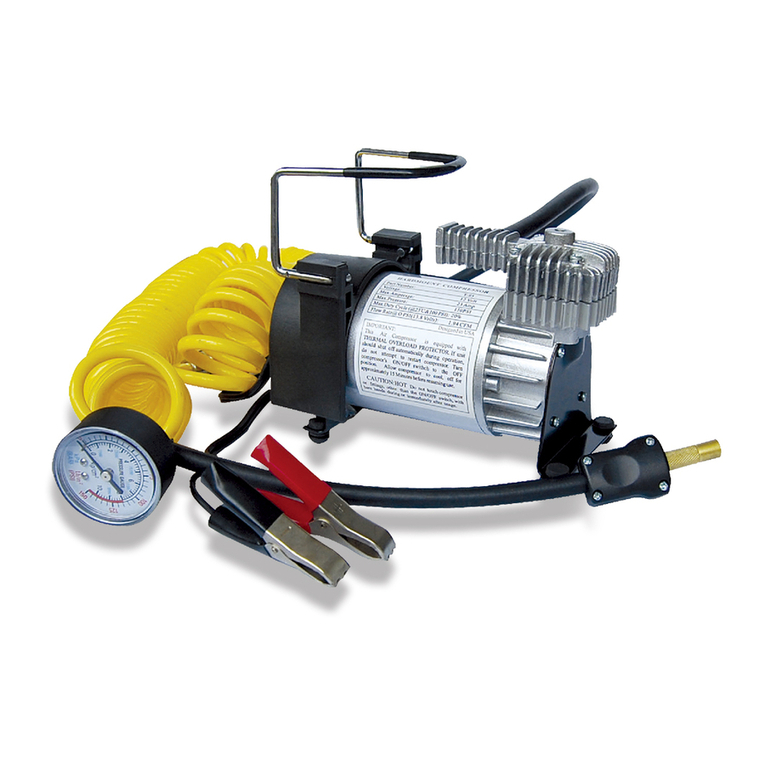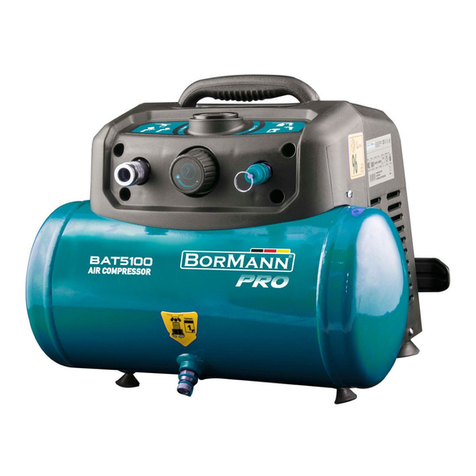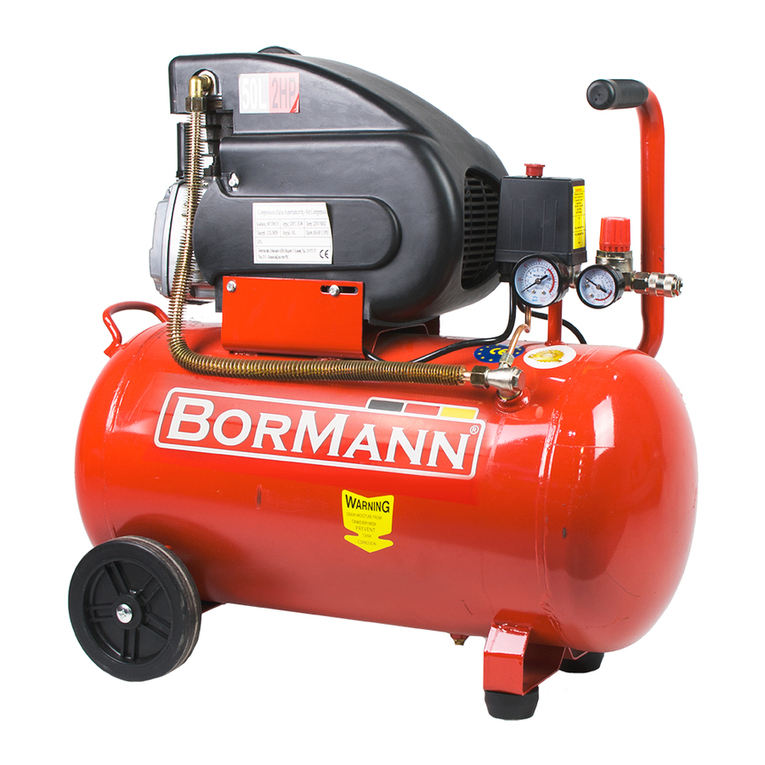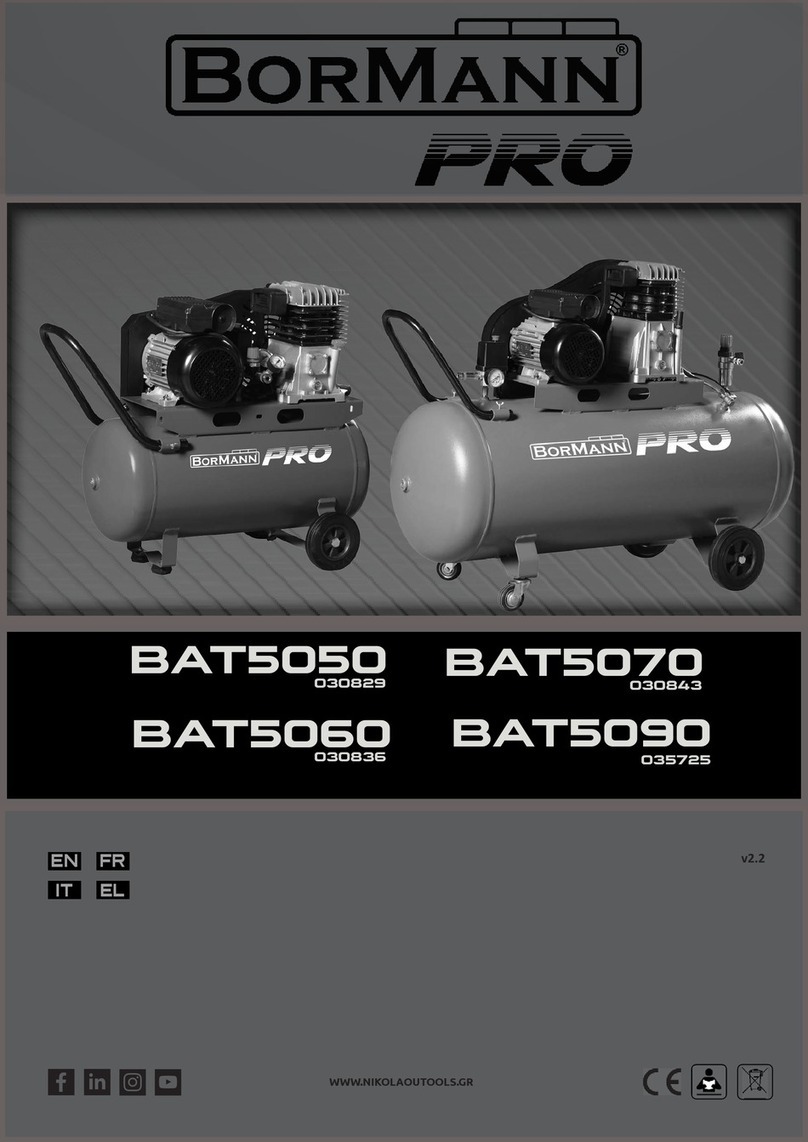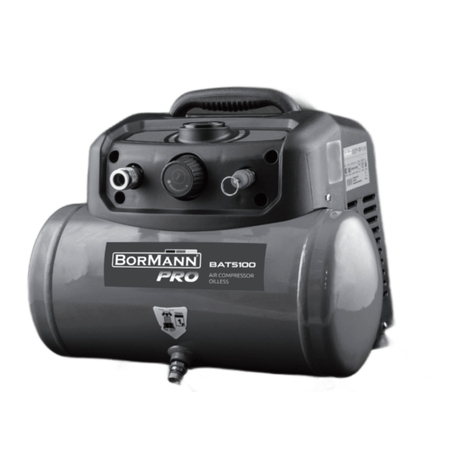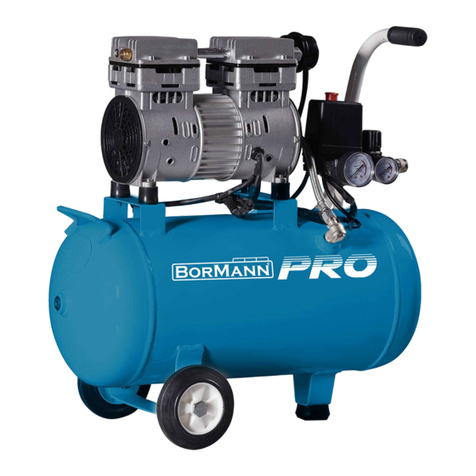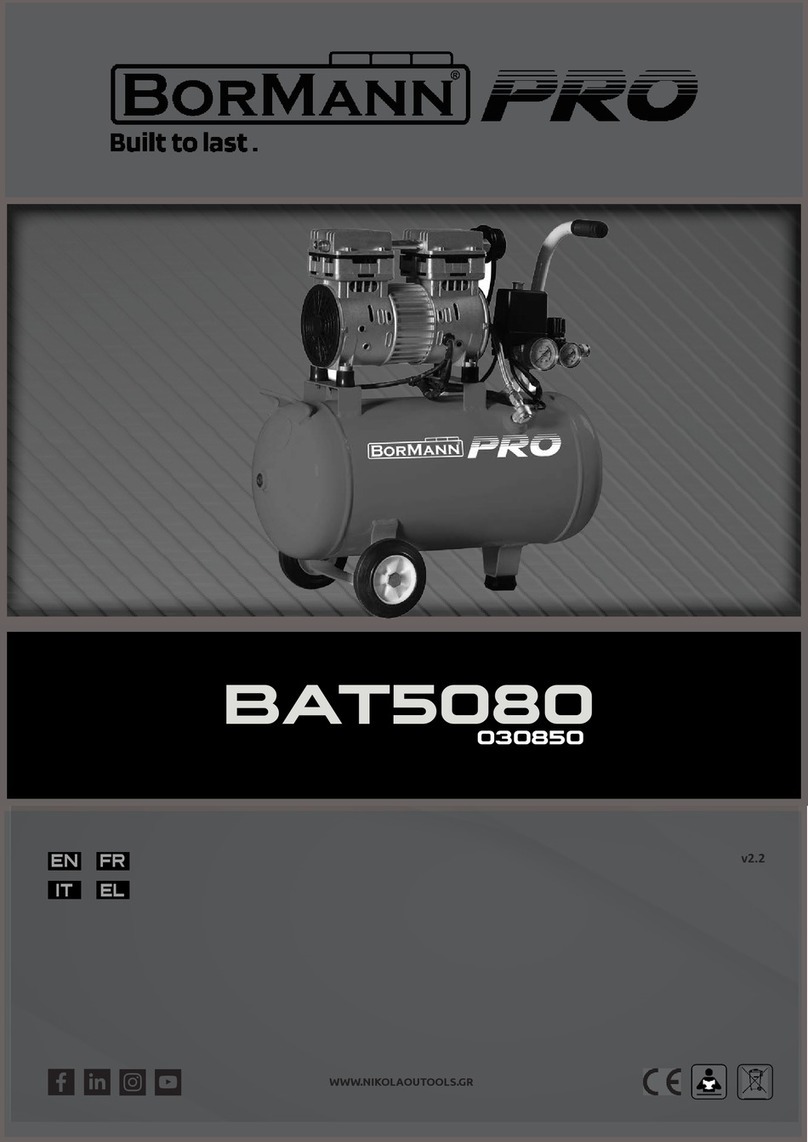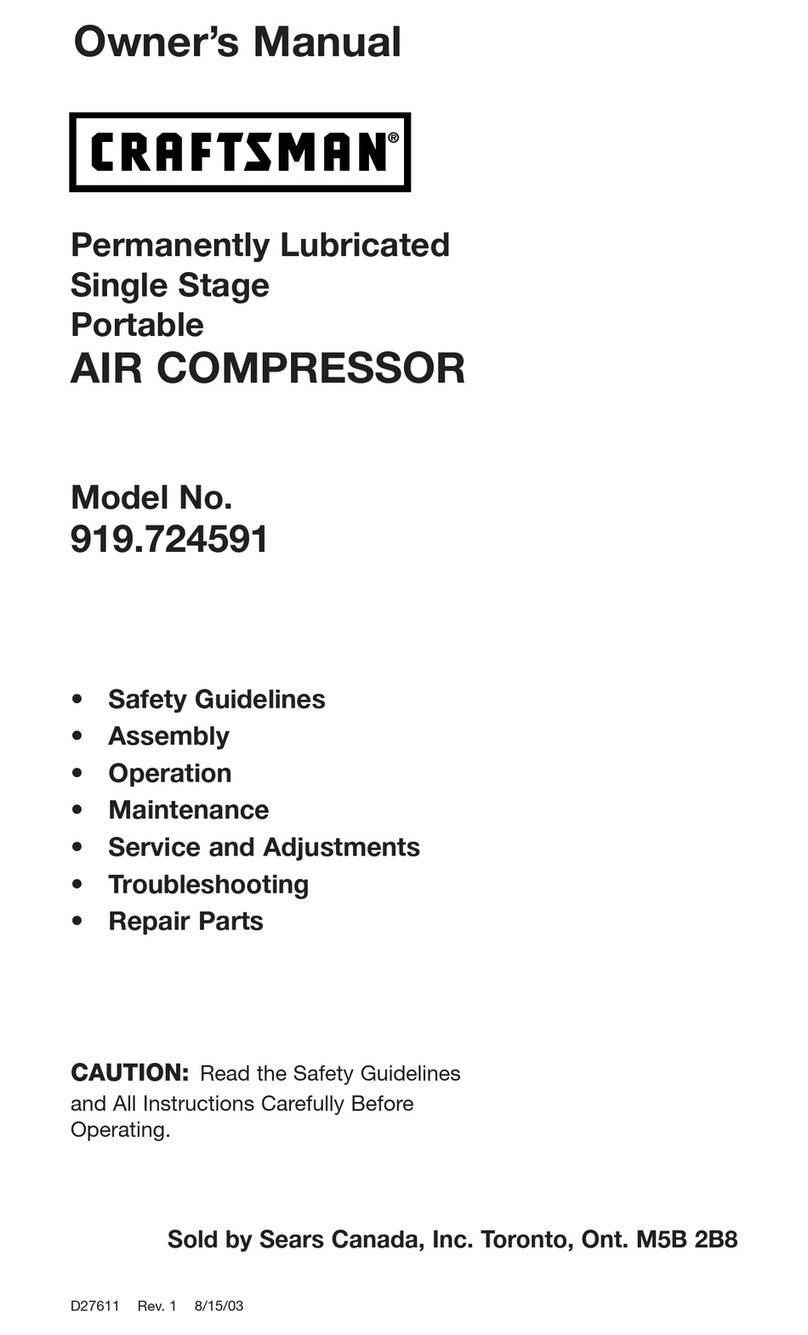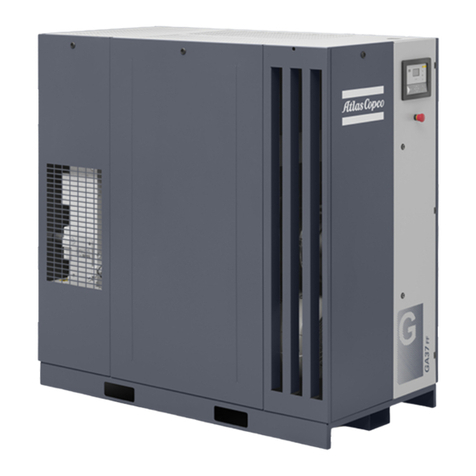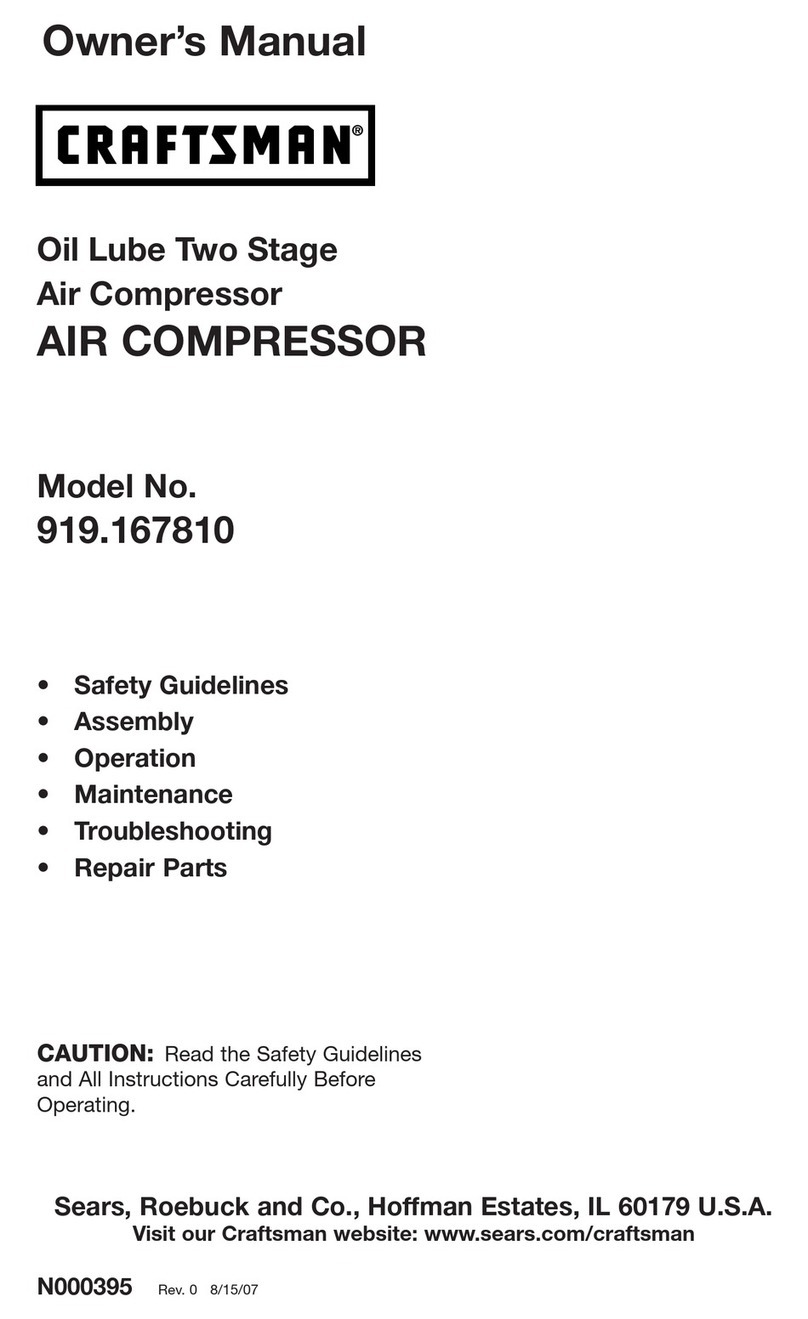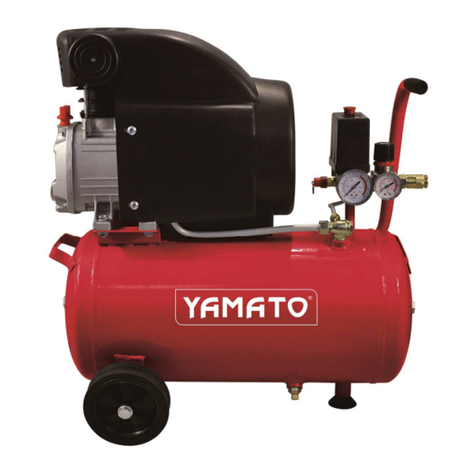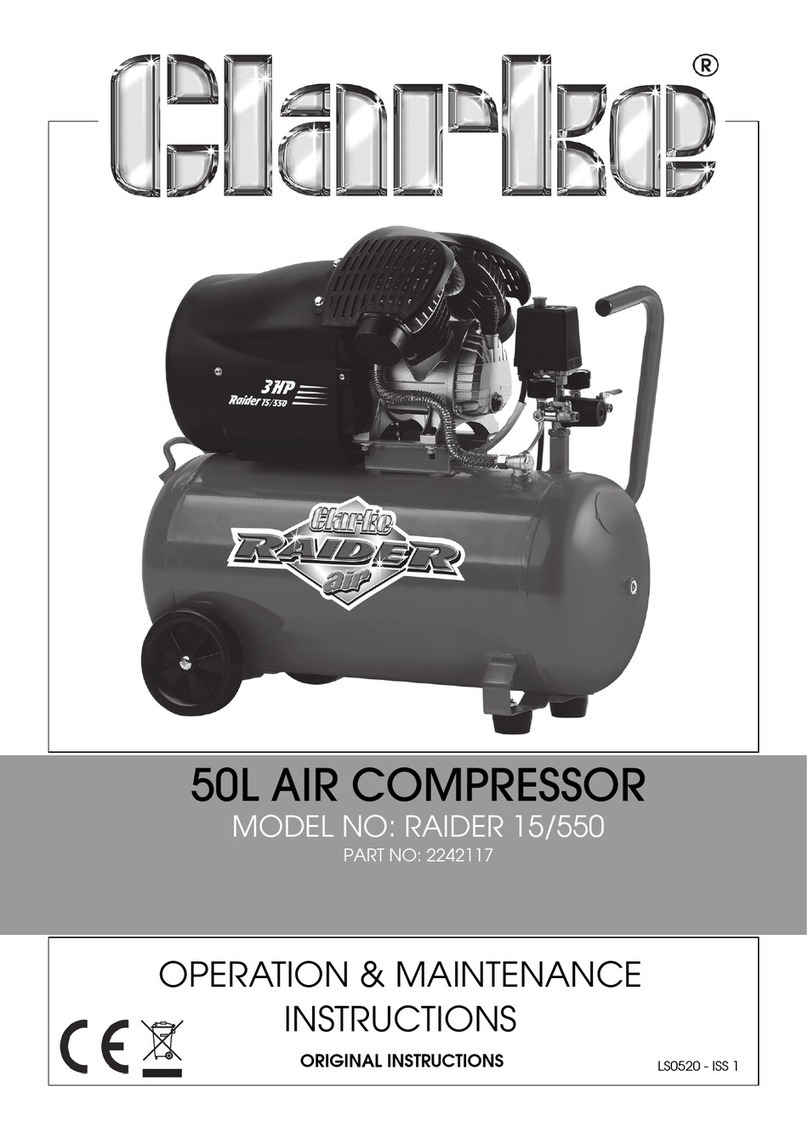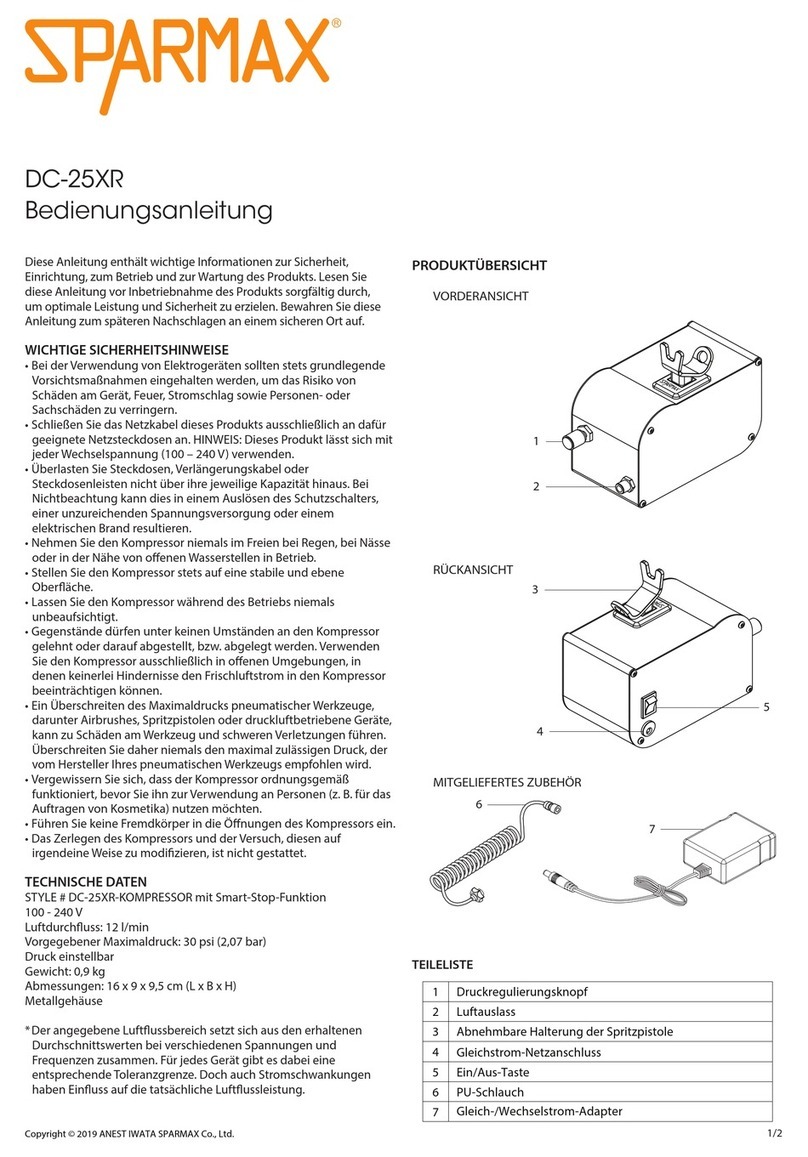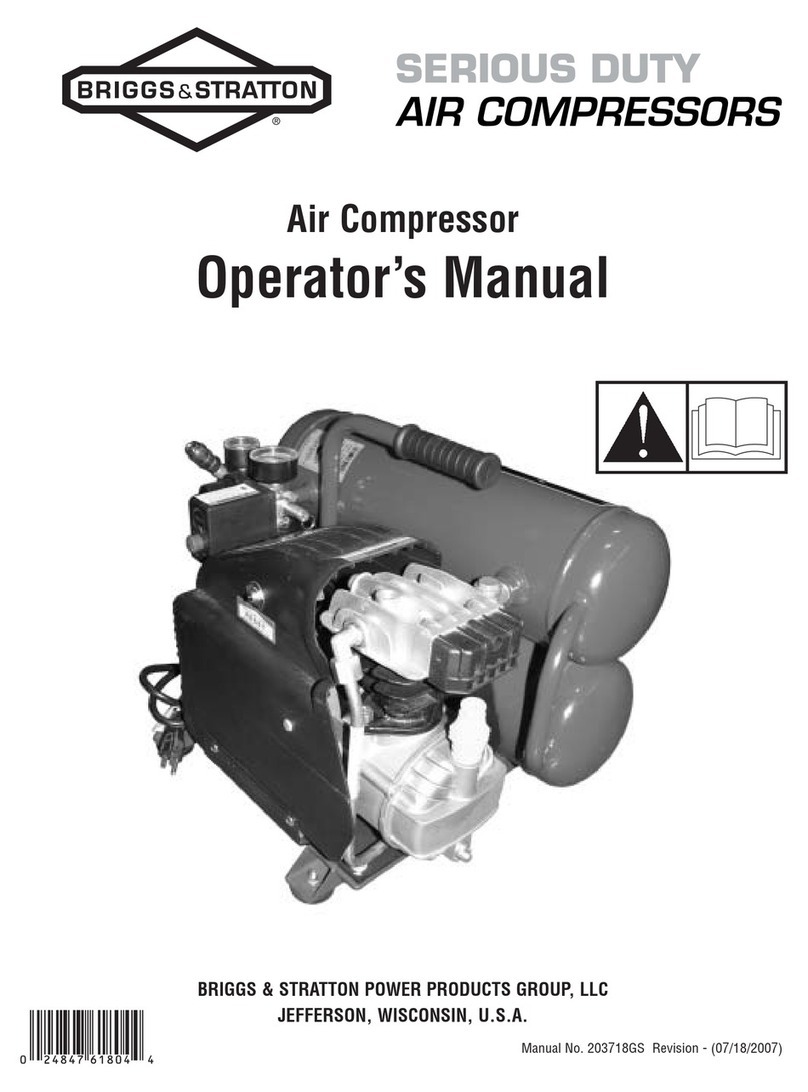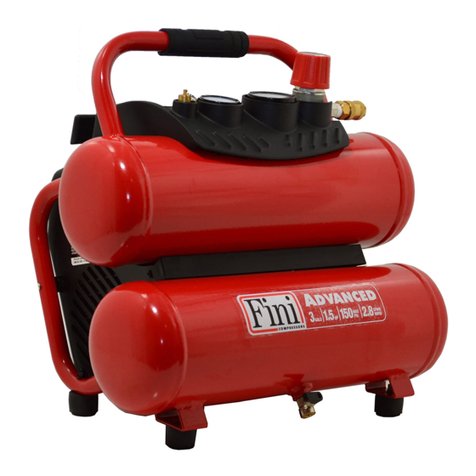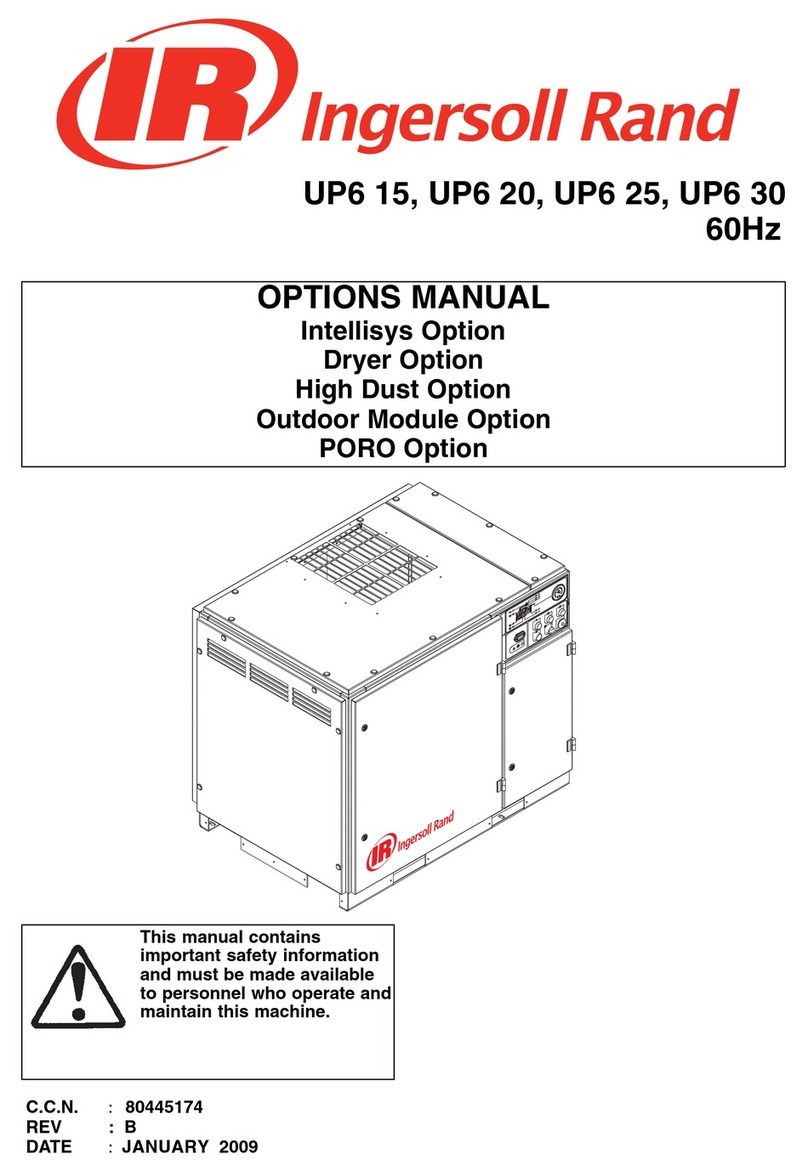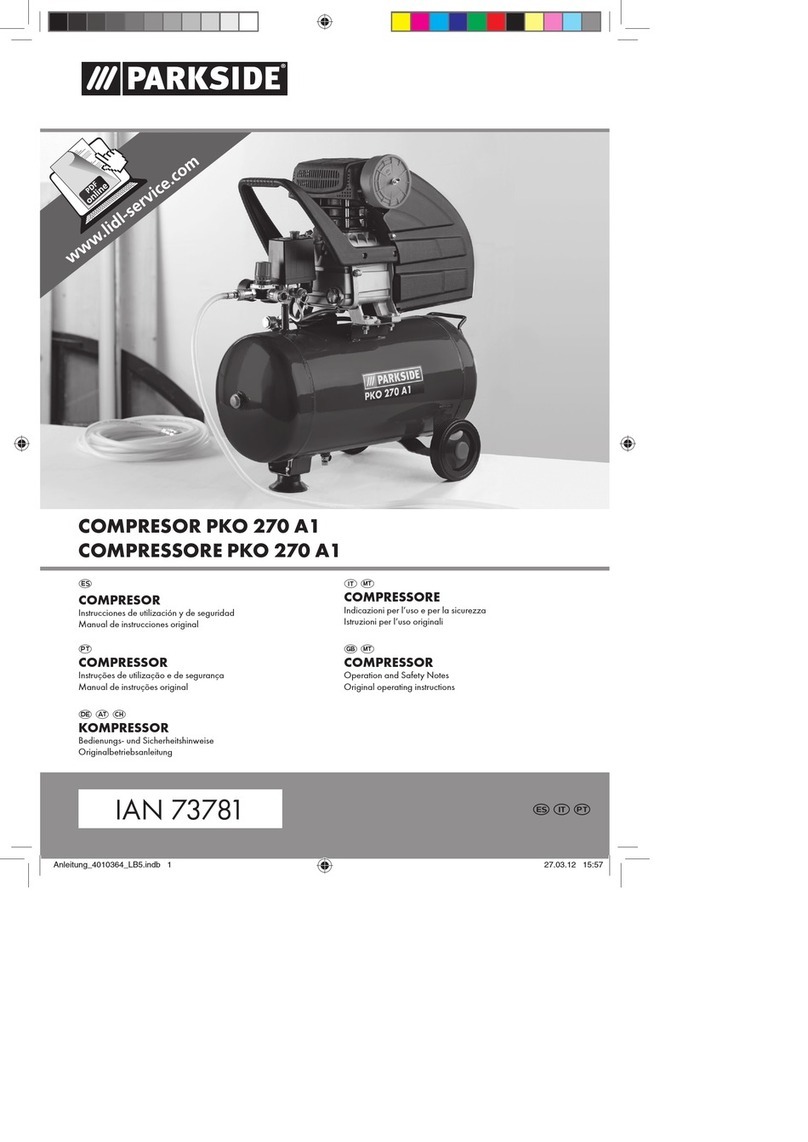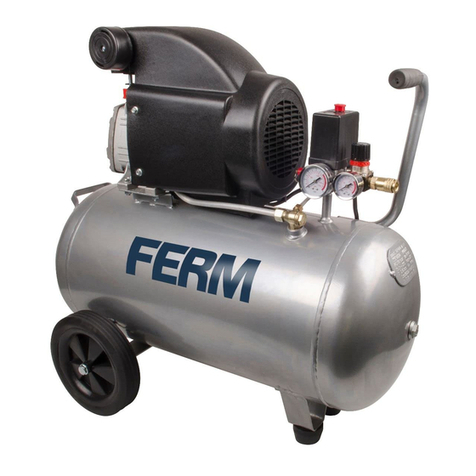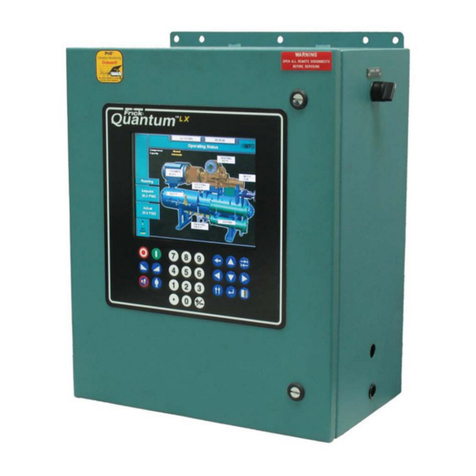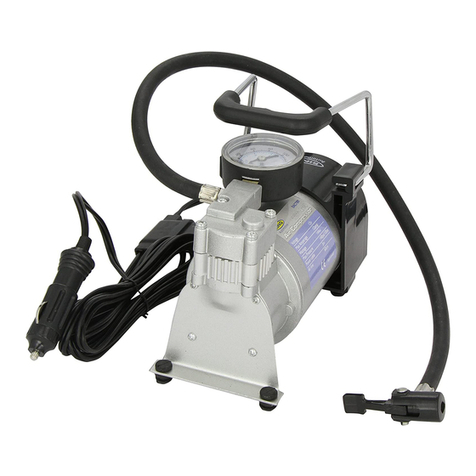
2
Safety Instrucons
Before opening the tank
Release the air pressure on the sand tank. To do this, turn off the air supply valve (19), and open the nozzle valve (19C), to release pressure in the line.
Ensure that the tank pressure gauge (16) reads zero, then open the tank.
Maintain correct air pressure
Pressure should not exceed 125 PSI. If it does , the safety valve (11) , is supposed to release the excess pressure. If this doesn't happen , stop all work
immedi-ately , and use the air compressor to reduce the excess pressure. Do not investigate the sandblaster's pressure problem until the pressure
gauge(16), reads zero.
Assembling The Sandblaster
1. Refer to the drawing for step 1, assembling the intake manifold (15).
First, attach the pressure gauge (16), to the top of the intake manifold, turning the gauge so that is can be seen across the top of the tank. Next, attach the
throttling valve (9A) to the bottom of the manifold. Attach the nipple connector (21), to the throttling alve. Attach the joint pipe (14), to the manifold.
2.
Refer to the drawing for step 2, to assemble the water trap filler (18).
Two nipple connector (17) are screwed into each side of the filler. On one side, attach the air supply valve (19), to the nipple connector (17), and then attach
the male/female connector (20), to the other side of the air supply valve. When you're ready to operate the sandblaster, the air hose from the compressor
will fasten to the male/female connector (20).
3.
Place the tank (01) on a table with the four clips up. Refer to the drawing for step 3. Screw the water trap filler (18) and its parts into the hole at the side of
the intake manifold. Then screw the open end of the joint pipe (14) with intake manifold (15) and pressure gauge (16) attached into the threaded hole on
the side of the filler pipe on op of the tank. Again, be sure that the manifold and gauge are vertical.
4.
Refer to the drawing for step 4, assembly of the sand outlet valve into the hole at the bottom of the tank. Attach four parts, in order: Nipple connector
(17); sand metering valve (19B); nipple connector (17) and the sand outlet pipe (23).
5.
Refer to the drawing for step 5, assembly of the nozzle shut of valve (19C). In this assembly process, you'll select one of the four nozzles (28). This is not a
permanent selection, as you may change nozzles according to the job being done. Screw the adapter (26), into the nozzle shut of valve (19C). Screw the last
nipple connector (17) into the other side of the valve. Screw the gasket (27) into the nipple connector, then add a nozzle (28) and the nozzle cap-nut (29).
6.
Refer to the drawing for step 6, for connecting the sand metering valve assembly (step 4) and the nozzle shut off assembly (step 5). Slide the two hose
clamps (24), over each end of the sand hose (25). Press one end of the hose, over the nipple on the sand outlet pipe (23), and the other end over the
adapter (26). Both hose ends should be firmly seated on the nipples. Slide the hose clamps along the hose to each nipple and tighten the clamps very firmly.
They have to resist the force of 0.65 to 125 PSI.
7. Fasten the two handlebars (06) to the tank using four pan screws (08) and four washers (10) and four hex nuts (09).
Note: keep the handle curve ends upward.
8. Locate the axle (05), and slide it through the holes in the sides of the handlebars (06). Place one wheel (02) at each end of the axle and fasten them into
place with copper pills (03) and washer (30).
9.
Insert the fitted foot (04) onto the fitting on the top of the tank near the edge. Use your last copper pin (03) to hold the foot to the tank.
10.
Before beginning operations, go back over each connection, double checking to ensure that all are tight and properly seated.
Abrasive selection
The kind of sand you choose will greatly influence the amount of time needed to clean a given surface area. Sandblasting materials include silicon carbide,
alumina, silica sand, bank sand and beach sand. However, bank sand and beach sand, even if washed, will still contain shell, coral and organic materials.
These absorb moisture much more readily than the other materials. As a result, the moisture in bank and beach sands frequently causes plugging of the
sand metering valve. If you elect to reuse sand, remember it does wear out. The sharp edges become rounder, and are less effective. It's at that point you
should replace the batch of sand you're using.
Loading abrasives into the tank
1. Check your abrasive to be sure it's dry, and won't clog the meter valve (19B), sand outlet pipe (23), hose (25), or other components.
2.
Put on the protective clothing.
3.
Turn the air supply valve (19) to the off (horizontal) position
4.
Open the nozzle shut off valve (19C) (vertical) position
5. Watch the pressure gauge (16) and make sure it reads zero pressure.
6.
Remove the filler cap (13) from the top of the tank.
7.
Insert the funnel (30), and pour the abrasive into the funnel. Be sure to get enough into the tank to do the job at hand. But if this is a big job, fill the tank
only 3/4 full, and reload as needed to finish the cork.
TIP: if the humidity is 90-100%, the water trap (18) won't be able to trap all of the moisture in a 3/4 full tank. Beer to reduce the amount of abrasive, load
more frequently, and empty the water trap more o en. This will reduce the possibility of clogging the bottom of the tank or the line.
8.
With the correct amount of abrasive in the tank, and close the filler cap (13).
9.
Close the nozzle shut-off valve (19C) and open the air supply valve (19).
10.
Check for air leaks at the filler cap as you begin to pressurize the tank from the compressor.
Maintenance
You should make every effort to protect your air compressor from any damage it may receive from your sandblasting work. Your best option is to keep the
compressor in a room separate from the sandblaster, using a long hose to provide the PSI needed to do your work. A second choice is to keep the
compressor up wind from the sandblasting, and the greater the distance between them, the better. Other than that, you should continue standard
maintenance procedures for the compressor.
2. Some parts of the sandblaster will wear much more rapidly than others. The parts needing close attention carry the air/abrasive mixture, starting with the
sand hose (25), and going through the metal fittings, the shut off valve (19C) and the ceramic nozzles (28).
3. If air leaks develop in any of these parts, you should stop all work, and find what needs to be repaired or replaced. When it is new, the sand hose (25) has 2
cord piles and the walls are 1/4" thick. As the interior diameter is sandblasted, this wall becomes thinner and thinner. One way to inspect the hose and other
parts are affected by the blasting is to put on your protective clothing. Then pressurize the system and close the nozzle shut off valve (19C). Close your hand
loosely around the hose and run it up and down the hose across the fittin and nozzles. You'll be able to feel any leaks. You can also spot places in the hose
where the
WWW.NIKOLAOUTOOLS.GR
